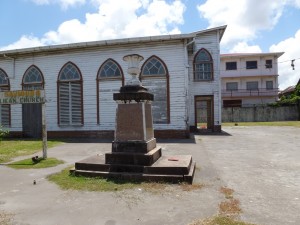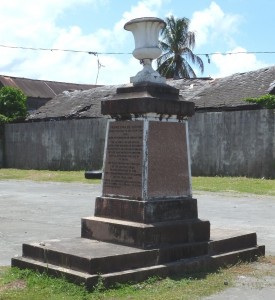
Saffon Street in Charlestown, Georgetown was named after Frenchman Louis Pierre De Saffon. The ward itself was built on the front lands of the former Plantation Le Repentir when the land was parcelled out and sold to cover his estate debts after his death in 1784 at 60; another account claims the lands were from the La Penitence estate.
Louis Pierre De Saffon was born in France – some researchers suggest Languedoc province in 1724 and became a land surveyor. However, in an act that was to profoundly change his fortunes, he murdered his brother during a duel (at the time outlawed in France) over a woman, and fled to the colony of Demerara seeking asylum.
In Demerara, he acquired much wealth, and became owner of plantations Le Repentir (Regret) and La Penitence (Remorse), which are said to have been named in repentance of his actions in France. There is also the suggestion of a Plantation Le Misère (Woe) being another De Saffon estate.
Although he never married, he is said to have had sired a daughter with his housekeeper.
De Saffon is also known, though less spectacularly, for the De Saffon Trust; a fund he had stipulated in his will for the care and education of orphans until they reached the age of 16. After his estate debts were cleared, the remaining funds were allotted for 10 native Demerara orphans to receive his charity.

According to The British Guiana handbook, 1913, the will also stipulated that, “under the terms of the will preference must always be given to the most poor and indigent and those born of white parents.”
It wasn’t until 1825, almost 40 years later, that the trust was put into existence with two beneficiaries. By 1834, 36 persons had benefitted from the trust fund, and in 1839 the Bishop of Guiana in his report on the Diocese declared the De Saffon Institution the only public school on the colony offering a grammar school education.
The grave site of De Saffon now lies at the corner of Broad and Saffon streets, in the church yard of St Saviour’s Church, once known as St Saviour’s Chinese Church since it was designated to provide a place of worship for the newly introduced Chinese population in Georgetown. (The word “Chinese” was omitted from the name in 1939, and the church is now known as St Saviour’s Parish Church). It was purchased in 1845 from the administrators of the Saffon estate.
The De Saffon Trust Act remains inscribed in Chapter 13:20 of the laws of Guyana, and is under ministerial authority.
A monument called The Saffon Monument was erected on his grave site in the church’s compound. Described as a granite monument, it reads in part, ‘Pierre Louis de Saffon: Born in France in the year 1724, and Died in Demerara in August 1784: The Revenue of his Estate, after other bequests, be bestowed in perpetuity, on the maintenance of ten poor destitute orphans, until attaining the age of 16 years.’



